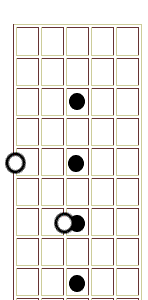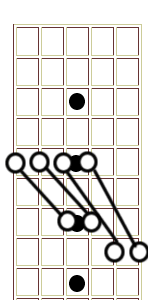What are intervals?
Intervals are the distance between 2 notes. Recognizing the sound of different intervals by ear is a key part of your development as a guitarist. We’ll learn all about intervals during our practice sessions. With the ‘Ear Training’ track we’ll enhance our intervals training by being able to identify intervals by ear from any reference tone.
The first intervals that we’ll learn today are unison and octaves.
Unison
A unison is two notes or more being sounded that are the same exact note. None of the notes will be at higher pitch or lower pitch, but the exact same pitch. Two voices singing the same exact thing could be said to be singing in unison. We can play unison intervals on the guitar, too. In fact, finding your unison intervals is a fun way to explore the fretboard and will help you with being able to find notes on the fretboard.
In the diagram below is an example of an unison interval:

Here’s a fun exercise for you. Play the first note in each measure and then find the note in unison on the A string. The A string, adjacent to the low E, is a higher pitch. Therefore, for our unison ‘formula’ all we have to do is take the number of the fret we are playing on the E string and subtract 5. For example, in the first measure, our note is the 6th fret of the low E string. If we subtract 5 from 6 we end up with 1. Therefore the same note will be found on the 1st fret of the A string. So, after you have played the 6th fret on the low E string, you’ll play the 1st fret of the A string.

Extra credit: identify the names of each note.
You can continue up the low E string in the manner explained above and find several unison notes. To make things a little interesting you can add slides to and from the notes to make them sound a little different.
You can do it on all the strings, but something funny happens when when you get to the B string. Instead of the +5 or -5 formula, you’ll use +4 or -4. Play through the exercise below to see what I mean:

A lot of people use unison notes to tune their guitar. It’s not the greatest tuning method, because one out of tune string will throw the subsequent string off, but it’s great for a quick tuning.
Octave
While the unison was the same note at the same pitch, an octave is the same note at a higher or lower pitch. Octaves are great to learn because you can use them a lot in songs and soloing.
In the diagram below you can see an octave built off of the 5th fret of the low E string. Both notes indicated are A notes, only the one on the 7th fret of the D string is at a higher pitch, or one octave higher, or you could say the A on the 5th fret of the E string is an octave lower than the one on the D string:

Here’s what they look like across all six strings:

Now, to present you with playable octaves, try the octaves in the tab below:
Notice how the pattern changes once you get to that pesky B string.
Try playing these octaves:

You may be wondering how you can play octaves without sounding the note on the string in between. The solution is easy. Just lay your first across the dead string- just enough to deaden it. Technically you’re muting that string.
Once you have to 2 octave shapes down, practice taking octaves all over the fretboard!
Try These Examples Of Octaves
You’ll find octaves used in all types of music. For example, “Fire” by Jimi Hendrix:

Wes Montgomery used octaves in much of his playing, often playing entire solos with them. Here’s an example of his playing in the song “Bumpin On Sunset”:

